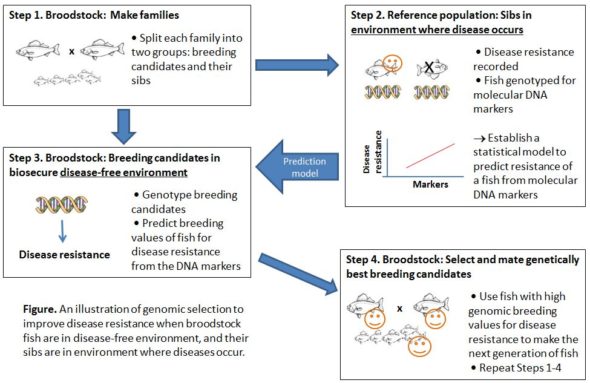AquaIMPACT objective: In AquaIMPACT, we develop economically sustainable, commercial-scale implementation of genomic selection for genetic improvement of Atlantic salmon, rainbow trout, gilthead seabream and European seabass in practical breeding programmes.
Main impact: More effective breeding programmes that are able to improve especially fish traits related to resource efficiency, disease resistance, fish welfare and product quality.
Current state: Genomic selection is already applied in terrestrial animals, such as dairy and beef cattle, pigs, and in fish especially in Atlantic salmon breeding programmes.
What is genomic selection?
- In selective breeding, the potential of individuals to transmit good genes to the next generation is estimated (i.e. their breeding value is calculated). Traditionally, pedigree information and phenotypic trait records from the individual itself and/or its relatives have been used to do this. Then, the broodstock fish with the highest breeding values are selected and used as the parents for the next generation. This leads to the genetic improvement in traits across the generations.
- In genomic selection, the breeding value of an individual for an animal trait is predicted based on a large number of molecular genetic markers distributed across the whole genome.
- Genomic selection utilises the naturally occurring genetic variation within a population, to genetically improve animal traits e.g. related to resource efficiency, disease resistance, fish welfare and product quality.
- The consequence of this technology is that the genetic potential of an animal can be predicted from a tissue sample and the DNA profile analysed from it, without a need to measure the trait itself from the individual.
- Genomic selection differs from strict ‘gene tests’, yet the basic logic is the same. In gene tests, the trait of interest is typically determined by a single or few genes. Instead, in farm animals, majority of the traits of interest are determined by multiple genes (thousands of genes of small effect).
- Hence, in genomic selection tens of thousands of genetic markers and the pedigree information are simultaneously used to predict the trait. This requires sophisticated computational methods typical for animal breeders.

